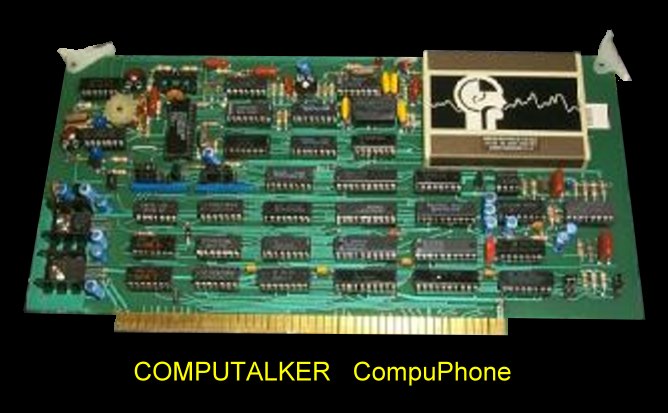he board was
S-100/IEEE-696 compatible and contained the following sub-systems.
An FCC-approved direct-connect to a telephone interface.
A Touch-Tone generator and decoder.
A speech digitizer.
An analog multiplexer that can select any of eight sources for connection to the
speech digitizer/telephone line interface.The direct-connect
telephone interface was capable of recognizing tones on the telephone network
such as dial tone, ringing and busy. The interface could pulse or Touch-Tone
dial, allowing CompuFone to originate calls as well as answer them.
Touch-Tones could be generated at any time and can be sent to the telephone
interface for transmission. Touch-Tones can also be received and decoded
to allow control of the program running the CompuFone. The speech digitizer
subsystem functioned as a "solid state tape recorder" by allowing speech or
other sound to be saved in either RAM or mass storage and reproduced on
playback. The speech digitizer used a hardware data compression technique to
reduce the memory and mass storage space needed to record messages. This data
compression technique achieved a 5-to-1 compression over an A/D converter. This
allowed acceptable quality speech to be recorded and played back at a rate as
low as 1.25K per second. This kind of compression made the storage of messages
on floppy disks feasible. A total of five sampling rates were available, from
1.25 to 4K bytes per second.
Finally, the analog multiplexer allowed any one of eight sources to be connected
to the internal audio bus. The internal audio bus, which feed both the telephone
line and the speech digitizer, was buffered and was available at a connector
(line-out pin) for attachment to an external amplifier and speaker. Seven of the
lines connected to the multiplexer were:- microphone, line-in, three aux lines,
the Touch-Tone generator, and speech digitizer output. The analog multiplexer
used three bits of the boards base port to control the selection of input. The
eighth choice is zero, which the documentation says was the telephone line.
However, the telephone line was always connected to the internal audio bus. I
believe this "selection" allowed the telephone line to be connected to the audio
bus without attenuation and without being mixed with any other source.
I do not have a manual for this board. If you would like to donate one (or a
better picture) please let me know.
In May 1984 Randy Reitz wrote up an excellent review of this board for
Microsystems (Vol 5, #5, p44). 

